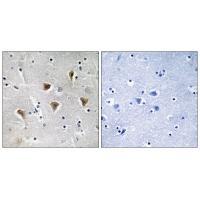

| WB | 咨询技术 | Human,Mouse,Rat |
| IF | 咨询技术 | Human,Mouse,Rat |
| IHC | 1/50-1/100 | Human,Mouse,Rat |
| ICC | 技术咨询 | Human,Mouse,Rat |
| FCM | 咨询技术 | Human,Mouse,Rat |
| Elisa | 咨询技术 | Human,Mouse,Rat |
| Aliases | MGC131634; mitochondrial transcription termination factor 1; |
| Entrez GeneID | 7978; |
| WB Predicted band size | 46kDa |
| Host/Isotype | Rabbit IgG |
| Antibody Type | Primary antibody |
| Storage | Store at 4°C short term. Aliquot and store at -20°C long term. Avoid freeze/thaw cycles. |
| Species Reactivity | Human |
| Immunogen | Synthesized peptide derived from internal of human MTERF. |
| Formulation | Purified antibody in PBS with 0.05% sodium azide. |
+ +
以下是关于MTERF抗体的3篇代表性文献摘要:
---
1. **文献名称**:*MTERF1 regulates mitochondrial transcription termination and cell proliferation*
**作者**:Park, C.B., et al. (2009)
**摘要**:研究通过Western blot和免疫荧光技术,使用MTERF1特异性抗体,揭示了该蛋白在线粒体转录终止中的作用,并发现其敲低导致细胞周期阻滞和增殖抑制。
---
2. **文献名称**:*MTERF3 controls mitochondrial ribosome biogenesis and embryonic development*
**作者**:Linder, T., et al. (2012)
**摘要**:利用MTERF3抗体进行免疫沉淀和蛋白质组分析,发现MTERF3通过调控线粒体核糖体RNA加工影响胚胎发育,缺失导致小鼠胚胎致死。
---
3. **文献名称**:*MTERF2 mediates oxidative stress response in mammalian mitochondria*
**作者**:Camacho, J.A., et al. (2015)
**摘要**:通过抗体染色和ChIP实验,证明MTERF2在氧化应激条件下与线粒体DNA结合,调节抗氧化基因表达,保护细胞免受ROS损伤。
---
如需具体DOI或完整引用格式,可进一步补充数据库检索信息。
MTERF (Mitochondrial Transcription Termination Factor) antibodies are essential tools for studying the regulation of mitochondrial gene expression. The MTERF protein family, primarily found in mitochondria, plays critical roles in transcription termination, RNA modification, and ribosomal biogenesis. Among its members, MTERF1 was the first identified and is best characterized for its role in terminating heavy-strand transcription, ensuring proper synthesis of mitochondrial rRNA and mRNA. MTERF2 and MTERF3 are implicated in transcription regulation and RNA metabolism, while MTERF4 associates with ribosomal subunits to facilitate translation.
Antibodies targeting MTERF proteins enable researchers to investigate their localization, expression levels, and interactions via techniques like Western blotting, immunofluorescence, and immunoprecipitation. These studies are vital for understanding mitochondrial dysfunction linked to diseases such as neurodegenerative disorders, metabolic syndromes, and cancer. For instance, altered MTERF activity has been observed in conditions like Leber’s hereditary optic neuropathy (LHON) and age-related pathologies, highlighting its role in maintaining mitochondrial homeostasis.
Commercial MTERF antibodies are typically raised against specific epitopes of human or murine variants, with validation in common model systems. Researchers must verify cross-reactivity and specificity, as mitochondrial protein families often share structural homology. Overall, MTERF antibodies provide a window into the complex mechanisms governing mitochondrial gene expression and their broader physiological implications.
×